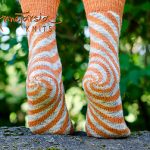
Our guest speaker this month was author, teacher, Master Knitter, and designer Anne Berk. Anne gave us a fascinating look at the world of knitting in print from the early part of the 1900s to today. Did you know that the first “real” knitting pattern book was Elizabeth Zimmerman’s “Knitting Without Tears”, published in 1971? Before that, knitters relied mainly on patterns published by yarn companies to sell their own yarns (often with no yardage information included, to make it more difficult to substitute a different yarn). These frequently had very brief instructions, no photos, and minimal (or no) illustrations.
In her educational talk, Anne shared her list of the most influential knitting books ever published, most of which are still available either as reprints or as used copies. Barbara Walker began publishing her stitch pattern collection in 1968, shortly before Zimmerman’s book. Next came “Knitting in Plain English” by Maggie Righetti, “The History of Hand Knitting” by Richard Ruit, “Principles of Knitting” by June Hemmons Hiatt, “Folk Socks” by Nancy Bush (first sock pattern book!), and Alice Starmore’s “Aran Knitting” (first “inspirational” knitting pattern book).

More recent classics on Anne’s list are Sally Melville’s “The Knitting Experience” series, Anna Zilboorg’s “Knitting for Anarchists” (first self-published knitting book), Stephanie Pearl McPhee’s “At Knit’s End” (first knitting humor book), and Cat Bordhi’s “New Pathways for Sock Knitters”, also self published.
If these books aren’t already on your shelves, check them out at the library or local bookstores–all are worth reading. And since Anne believes that knitting book publishing is changing fast, these books (and many others) may become “rare” books very soon.
She said that today, publishers look for “super magazines”–books that can be printed and the entire edition sold out within six months, because bookstores don’t want to stock the same book for years. This means there isn’t as much original content, and there’s less time to tech edit or test knit the patterns, leading to more errors. Plus, designs are streamlined to be as short as possible, with smaller charts and standardized stitches. Designers with original ideas that may not appeal to a wide audience must self-publish, which is expensive and very time-consuming. Even patterns that are published online must be professionally photographed, tested, and edited, so they are costly to produce.
